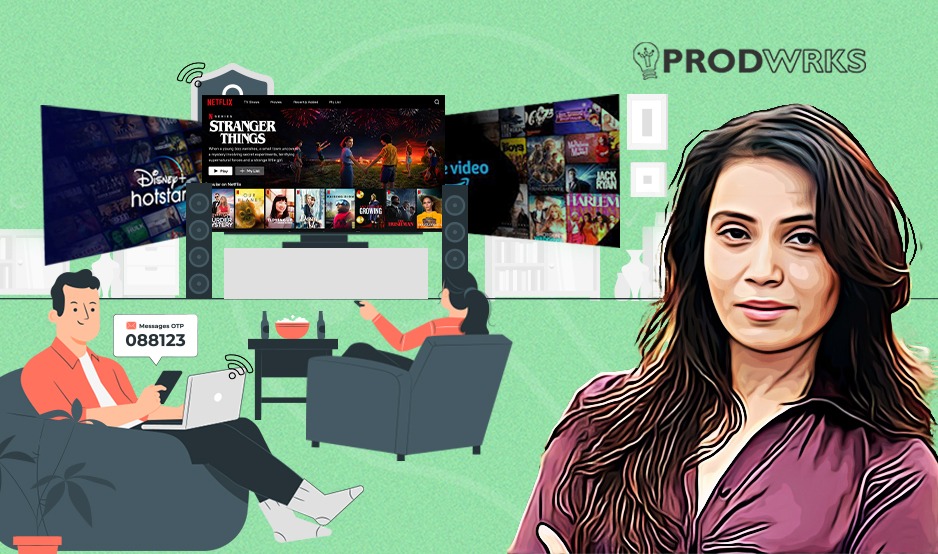
Recently, we saw a crackdown on password-sharing by Netflix and following in its footsteps, Disney+ also enforced strict policies this month to curtail multiple users sharing passwords and using the same account. As OTT platforms compete for market share, they seek ways to maximize monetization and decrease revenue leakage.
Strict password-sharing policies are one way to achieve this, as they force users to either create their own accounts or pay an additional fee for shared access. While this strategy has invited the ire of OTT subscribers, it is not deterring the OTT platforms and we foresee other major players following the example set by Netflix and Disney+.
To get detailed insights into password-sharing policies of OTT players and how they affect platform revenue and user behavior, we reached out to Divya Dixit, an independent strategy consultant for media companies who have been in leadership positions at organizations of the likes of ZEE5, Sony, UTV, Tata Docomo, ALTBalaji, to name a few.
Password Sharing: A Double-Edged Sword
Divya is a dedicated OTT consumer with multiple subscriptions and disclosed that she shares passwords within her family across international borders, like countless others across the world. While this practice may lead to potential revenue loss for platforms like Netflix, Amazon Prime, and Hotstar, Divya has a different perspective.
“If we look at it one way, the OTT platforms may lose subscriptions. However, they also need to remember that this sort of increases their reach. Tomorrow, if they come down heavy on password sharing, the other people with whom the passwords have been shared are so hooked on to the content that they might be tempted to buy their own subscriptions. But, in a way, when I do password sharing, I, as a consumer become a brand ambassador of the platform.”
This unique perspective challenges the traditional notion of password sharing and piracy, showing it as a complex yet potentially beneficial aspect of the OTT landscape.
User Behavior in India's OTT Landscape
Reflecting on Netflix’s strict password-sharing rules that led to frustrated users resorting to piracy or turning to illicit websites for content, Divya says that OTT platforms must be extra careful when it comes to price-sensitive markets like India.
Divya said, “India is a very economy-oriented market. You can't get too strict with people over here because the moment you do, people will go and find alternatives. While metros can't live without Netflix and Amazon, the tier-2, tier-3, and tier-4 towns and hinterlands can very well live without Netflix and Amazon because they have multitudes of platforms. Now, regional platforms are also coming into play, making content in regional dialects. I can assure you that India is not a country where you can get very strict with people on entertainment.”
As a side note, Divya also dissected Inox and PVR’s attempt to boost weekday footfalls with a movie subscription plan (PVR-Inox Passport – Rs. 699) that lets a subscriber watch up to 10 films in a month on weekdays for Rs 699.
Commenting on the subscription plan, Divya said, “First of all, what we need to understand is that OTT and cinema will coexist, its broadcast, that is threatened by OTT. But, this plan itself has basic flaws. It’s 699/- per head, while an OTT single subscription can cost the same for the entire family. It’s only on weekdays, and very few people have that kind of time. It has a limit of 10 movies per month, unlike unlimited content on OTT.”
Strategies to Combat Password Sharing
While addressing the prevalent challenge of password sharing on OTT platforms, Divya proposed a strategic approach focused on incremental plans.
“One smart way of doing this is possibly doing an incremental plan. For example, if two or more households share an OTT platform with the same password, the OTT can put slightly incremental pricing on the second household. So, the OTT platform will still get a better reach, while getting paid for the extra household using the platform. It might not be the full subscription price, but the consumer still ends up working as a brand custodian,” suggests Divya.
This approach ensures that consumers still contribute financially, albeit not at the full subscription price, while acknowledging indirect organic promotion that occurs through shared passwords.
Divya says, “Since India has a very price-sensitive population, an incremental plan works the best here. People will be more open to that idea rather than the OTT saying - this is a piracy shutdown. A shutdown means you've lost the consumer. The consumer may or may not come back,”
“But the moment you say - We're very happy that you love our content and you see it across so many households. However, we recommend that you pay X amount extra to continue watching - the consumer will be a little more open to the idea of paying extra,” explains Divya.
Divya also highlights the lack of effective methods to end the password-sharing practice, asserting that geofencing via VPN tracking remains the sole viable approach. However, she also highlights a potential downside, as stringent measures might alienate customers, leading to potential subscription losses.
“The only strategy is geofencing via VPN and shutdown. In this case, the con is that the customer might walk away and never come back. The pro is that instead of one subscription, OTT gets two or three subscriptions.”
Divya emphasizes the challenging task of individual customer tracking, underscoring the need for dedicated tech teams to manage VPN monitoring effectively.
Pricing Strategies and Market Penetration
Discussing pricing strategies, Divya applauds Netflix’s mobile plan but advocates for a more localized approach.
“Pricing-wise, Netflix is doing some great work now that they have come down to 199 from their mobile plan, too. You can watch it on mobile, TV, or laptop. I think they have done some good work over there. If they push the Hindi market better, they should see a better penetration. They've already come to about 5.5 million subs on the back of this 199 plan.”
She also praises Amazon India’s comprehensive content strategy, language inclusivity, and innovative revenue models like live channels.
“Amazon is doing better work in terms of their annual planning strategy. If you look at it from a pricing and content strategy perspective, honestly, Amazon is doing some great work. They have movies across languages, which makes it a platform open to everybody. Plus, they have started Amazon live channels, which has taken into account other platforms, and they have opened it up as a revenue stream where they're earning revenue selling the other platform subscription."
Talking about Zee5, Divya said, “Zee5 is unfortunately not able to cut across metros the way it would have wanted to. They can do some great work cutting across regional markets and cutting across tier-2 and tier-3 markets. They're very focused right now on fighting the fight in metros.”
Future of OTT Platforms
Divya predicts a promising future for OTT platforms, asserting their eventual replacement of traditional broadcast mediums.
“Traditional broadcast mediums are going to fold up eventually. It is already losing revenue. Broadcast has already bought down its content budgets and marketing budgets. They are fighting to stay alive in the market. I think the future is that OTT is going to replace broadcast. Broadcast will remain more or less in the form of only free-to-air channels. Paid channels will go away because, eventually, everything has been digitized. Even the internet is the cheapest globally in India.”
With digitization permeating every aspect of entertainment, Divya believes that OTT platforms will coexist with the cinema-theatre experience and continue to evolve.
“In another 5-6 years, OTT will replace broadcast. But OTT and movies/cinema will coexist. OTT has become the mainstream. Tier 2 and Tier 3 have also adopted it fully. Broadcast will just remain in India in dark markets where broadband and 4G have still not penetrated. And those are literally the hinterlands of India's dark markets.”
Divya envisions the integration of technologies like Augmented Reality (AR), Virtual Reality (VR), interactive shows, and gamification, transforming the viewer experience in the next five to six years.



